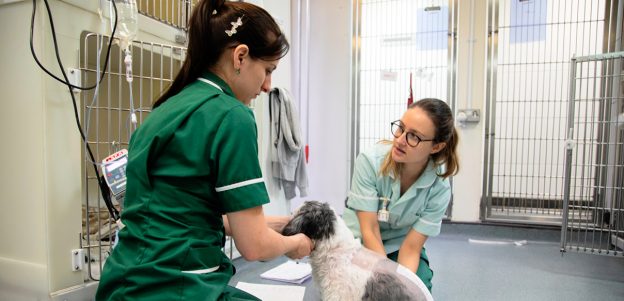If you’re a Registered Veterinary Nurse (RVN) or veterinary surgeon, chances are you’ve explained a procedure to a nervous client, supported a student through a tough day, or guided a colleague through a new skill – probably without even thinking of it as “teaching.” RVNs make some of the best teachers, often long before they officially step into an education role.
Whether you’re considering becoming a clinical supervisor, moving into lecturing, or just want to explore new ways to share your knowledge, teaching could be a natural next step. Here’s why RVNs and vets are uniquely suited to it and how you can get started with work-based training and teaching qualifications:
1. You’re already teaching – you just might not call it that yet
Think about how often you’re explaining, demonstrating, reassuring or checking understanding in your daily role. Whether it’s showing an SVN how to prep for theatre, talking a pet owner through post-op care, or mentoring a new team member, you’re constantly passing on knowledge in structured and supportive ways. That’s teaching in its most practical form.
2. You know how to communicate clearly and compassionately
Good teachers aren’t just experts in their subject. They also know how to make that knowledge accessible. As an RVN or veterinary surgeon, you already tailor your communication to suit different people: clients, students, receptionists and more. You break down complex information into understandable chunks, stay calm under pressure, and adjust your approach depending on who you’re speaking to. That adaptability is a huge part of what makes a great educator.
3. You’re patient, practical, and solutions-focused
Veterinary work demands resilience, empathy, and a calm head – all of which are essential for teaching too. Students and new learners need time, repetition, reassurance, and space to make mistakes. RVNs and vets understand that learning is rarely a straight line. Your practical experience means you’re not just teaching theory, but giving people real-world insight and helping them feel capable in a clinical setting.
4. You understand what it feels like to be a learner
Most RVNs and vets remember their own veterinary training well, including the clinical supervisors who supported them, the ones who challenged them, and the times when things felt overwhelming. That memory gives you empathy and perspective when you’re helping someone else along the same path. Ultimately, because you’ve been in the same shoes, it also helps you create a learning environment that’s both kind and effective. Being in a career that involves lifelong learning also means you’ll be more comfortable when it comes to undertaking a formal teaching qualification.
So, how do you become a teacher as a veterinary professional?
If you’re interested in sharing your veterinary skills more formally, there are a few ways to get started.
You might begin by becoming a clinical supervisor and mentoring Student Veterinary Nurses (SVNs) in practice. This role allows you to guide and assess students as they work towards their veterinary nursing qualifications. Alternatively, if you’re drawn to classroom-based teaching, you might explore opportunities in veterinary nursing colleges or further education. You can read frequently asked questions about becoming a clinical supervisor here.
Either way, building your confidence and skills as a teacher can be hugely helpful. Many people start by completing introductory teaching qualifications such as the City & Guilds Level 3 Award in Education and Training, which gives you the tools to plan sessions, support learners with different needs, and reflect on your own teaching style – even if you’ve never stood at the front of a classroom before.
A helpful resource: Guide to Becoming a Veterinary Nursing Lecturer
Our comprehensive Guide to Becoming a Veterinary Nursing Lecturer offers step-by-step advice for veterinary practice professionals considering a career in education. It covers essential topics such as teaching qualifications needed, typical career paths, roles and responsibilities, and suggestions for enhancing your CV and interview readiness. Whether you’re aiming for college-level teaching or guest lecturing, this guide helps clarify what to prepare and expect, demystifying the transition from clinical practice to education. Download the Guide to Becoming a Veterinary Nursing Lecturer here.
Being a great teacher isn’t about knowing everything. It’s about being curious, compassionate, committed to helping others grow, and eager to improve your own practice by undertaking formal training or teaching qualifications – all things RVNs and vets already excel at. If you enjoy supporting others, explaining things clearly, and seeing people succeed because of your guidance, teaching could be an incredibly rewarding next step in your career. Whether that’s coaching in practice, teaching in a college, or running CPD in the future, it starts with recognising the teacher you already are.
Level 3 Award in Education and Training at The College of Animal Welfare
If you’re passionate about education and looking to step into a teaching role, the City & Guilds Level 3 Award in Education and Training is an excellent starting point.
This recognised teaching qualification is suitable for veterinary professionals who want to gain the teaching skills needed to become lecturers, clinical supervisors, or trainers within the veterinary industry.
Whether you’re looking to move into full-time lecturing or simply enhance your ability to mentor and educate students in practice, this course will equip you with the confidence and expertise to deliver engaging and effective teaching.
Why choose this course?
- Tailored to your teaching goals Gain essential teaching and assessment skills with a course suited to your experience and career goals.
- Online learning All your course materials, support and assessment will be provided online, allowing you to fit training around your other commitments.
- Recognised teaching qualification Open doors to teaching roles in colleges and private training providers.
- No teaching experience required You don’t need to be in a teaching role to enrol, making this the perfect way to explore a career in education.
- Practical and engaging Learn how to plan lessons, assess learners, and create inspiring training sessions.

